Authors: Komal Ramchandra Pawar1*, Swapnil Gorakh Waghmare2
1VDCOAB, Vasantrao Naik Marathwada Agricultural University, Parbhani-431402
2CPBMB, Kerala Agricultural Univrity, Thrissur-680656
A transgenic animal is one that carries a foreign gene that has been deliberately inserted into its genome. In the early 1980, Ralph L. Brinster and Richard Palmiter developed the techniques responsible for transgenic mice, rats, rabbits, sheep, and pigs. This process of transgenic animal is slow, tedious and expensive.
The first transgenic animal was produced is mice, by injecting DNA to mouse embryos then implanting the embryos in female mice.
Applications of Genetically modified animals:
• To yield industrial as well as consumer product
• To research human diseases
• To produce pharmaceutical products and tissue for implantation
• Also to improve the health of animals for disease resistance
• It can also be used for experimental models to perform phenotypic
• For the development of proteins that are used in medical treatment are produced by altering DNA or transferring DNA to an animals
Transgenic Mice
The first genetically modified organism i.e. mouse was created by Rudolf Jaenish in 1974. For the gene transfer technology mostly chosen animal is Mouse. Mouse has features that their tissues and organs are similar to that of a human. Furthermore, they carry virtually all the same genes that operate in humans. Moreover, it reduces cost of research.
The transgenic “Super Mice” is developed in 1982. It was hereditarily transformed to produce the human drug, tPA (tissue plasminogen activator to treat blood clots).
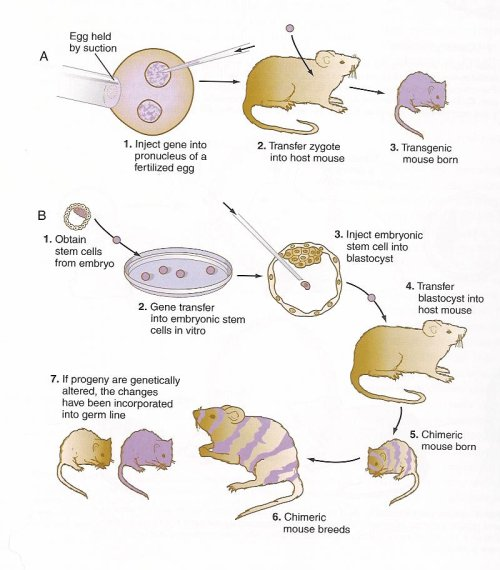
Fig: Transgeneic Mice Production
File Source: https://www.researchgate.net/figure/292262701_fig25_Figure-26-Genetic-mouse-models-A-Transgenic-mice-are-generated-by-pronuclear-injection.
Transgenic Pigs
The amount of transgenic manufacture in pig is lower than in mice. In 2006, a pig was engineered to yield omega-3-fatty acids through the manifestation of a roundworm gene. In swine during microinjection method for transformation, swine ova contains a large amount of lipids, which makes the poor or very difficult visualization of male pronuceli. However, centrifugation of pig ova enables visualization of pronuclei, which allows microinjection of DNA into the male pronuclei. Fluorescent pigs have also been produced for study of human organ transplant i.e. xenotransplantation or considered for being potential source of different organs for the xenotransplantation. Sperm mediated gene transfer method is highly efficient for production of transgenic pig.
The chief objectives of transgenic pig production are increased growth and meat production and xenotransplantation. In addition, the gene for human histocompatibility have been studied in transgenic pigs.
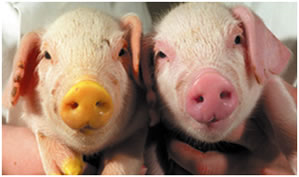
Fig: Transgenic pig
Image source: http://arbg.missouri.edu/labs/prather/history.php
Transgenic cattle
The microinjection of fertilized ova is the successful transfection technique in cattle. Main objective of production of transgenic cattles are increased milk production, meat production and molecular farming.
Several human genes have been successfully transferred in cows and expressed in the mammary tissue. The most important application is to treat disease like mastitis. Lysostaphin kills the bacteria Staphylococcus aureus, which causes mastitis in cow. This lysostaphin is secreted in milk of transgenic cows consequently, they show resistance to mastitis.
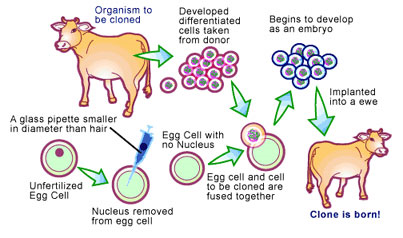
Fig: Transgenic Cattle production
Image source: https://www.scq.ubc.ca/the-new-macdonald-pharm/
Transgenic sheep:
The main significant objective of transgenic sheep production is better growth and meet production, for this Human Growth Hormone gene is inserted in sheep. Furthermore the key research efforts of transgenic sheep is increased wool production and improved wool quality. To achieve this genes involved in keratin biosynthesis are being identified and cloned. In addition, the two bacterial genes concerned with cysteine biosynthesis cysE and cysM have been introduced in sheep by cloning. In merino sheep, the single major autosomal gene for fecundity the Boroola fecundity (Fec B) gene identified responsible for increase ovulation rate.
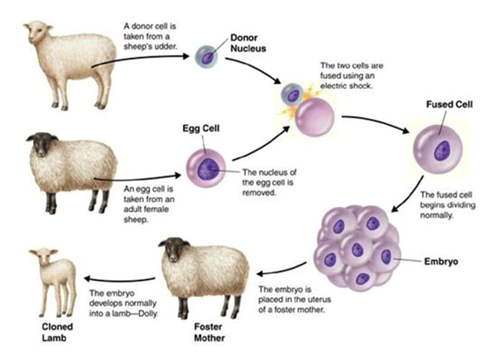
Fig: Transgenic Sheep production
Image Source: https://www.animalsciencepublications.org/publications/af/articles/3/3/14
Transgenic fish:
Transgenic fish are used for scientific research and as pets and an aquatic pollution sensor. Some fish are successfully transformed such as gold fish, catfish, common carp, rainbow trout, atlantic salmon etc. There are two species of fish such as zebrafish and medaka are commonly modified because they have optically clear chorions (membranes in the egg) rapidly develop and the one cell embryo is easy to see and microinject with transgenic DNA. The salmon or rainbow trout growth hormone, chicken δ-crystallin protein, winter flounder antifreeze protein these are transfored into fish. Also the E.coli β-galactosidase and E.coli hygromycine resistant gene is transferred.
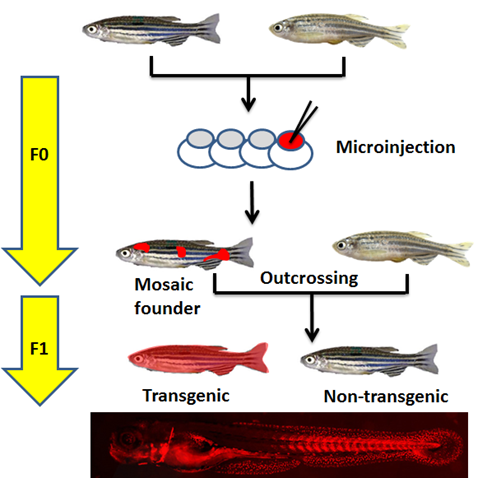
Fig: Transgenic fish production
Image Source: http://tgfish-zgenebio.weebly.com/transgenic-service.html
Advantages:
• Transgenic creates new medicines and treatments for illness.
• Benefits agriculture and industries by being more profitable
• Construct disease resistant animals and humans
• This will lead to more discoveries in science, for researchers it will helpful for further study
Disadvantage :
• Animals have a low survival rate
• Usually leads to breeding problems
• Leads to mutations and functional disorders
• A new disease could be created
• Ethical issues
References:
Singh B. D. (2004). Biotechnology expanding horizons. Kalyani publishers. Pp. 347-349.
About Author / Additional Info:
Research scholar in VDCOAB, Vasantrao Naik Marathwada Agricultural University.